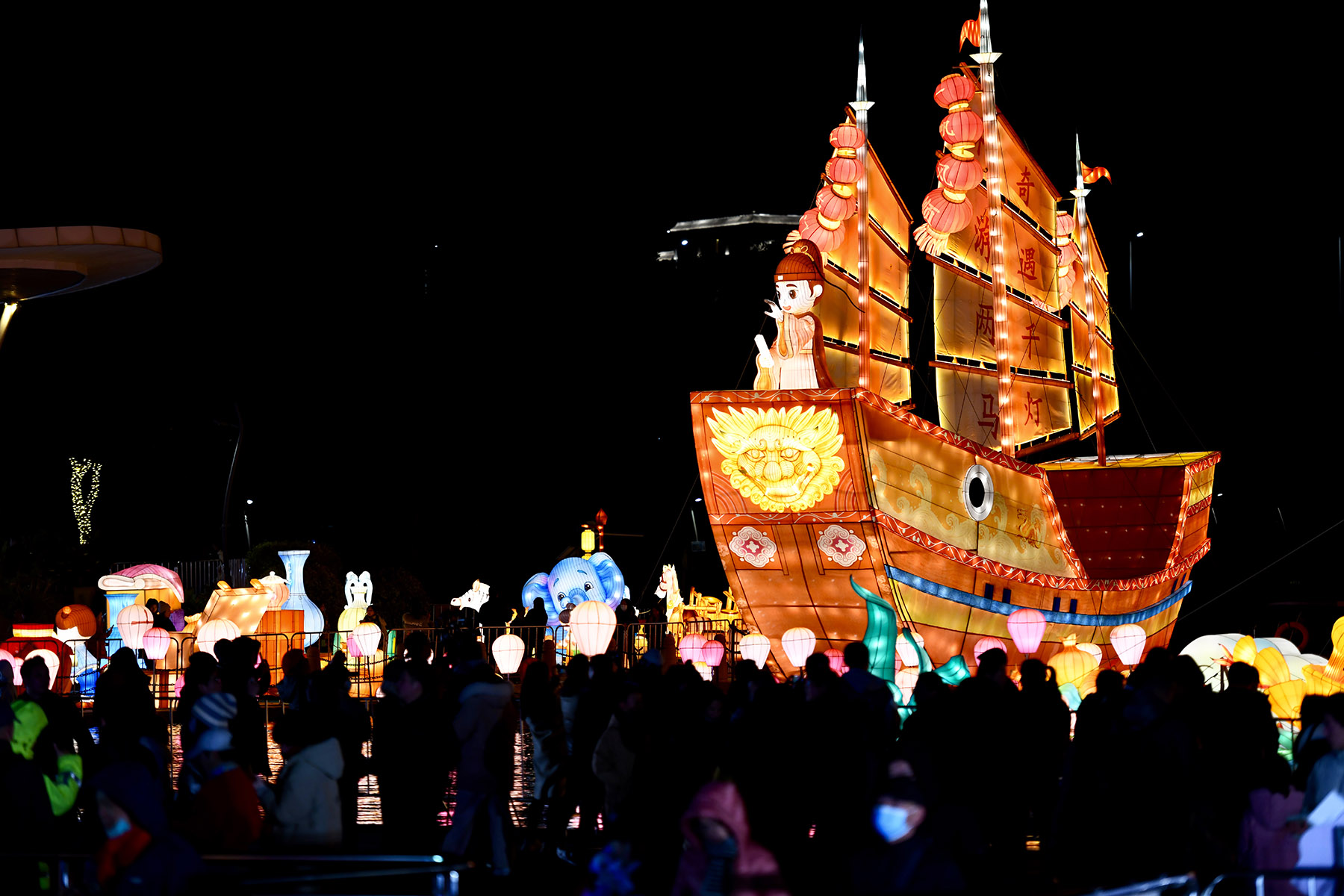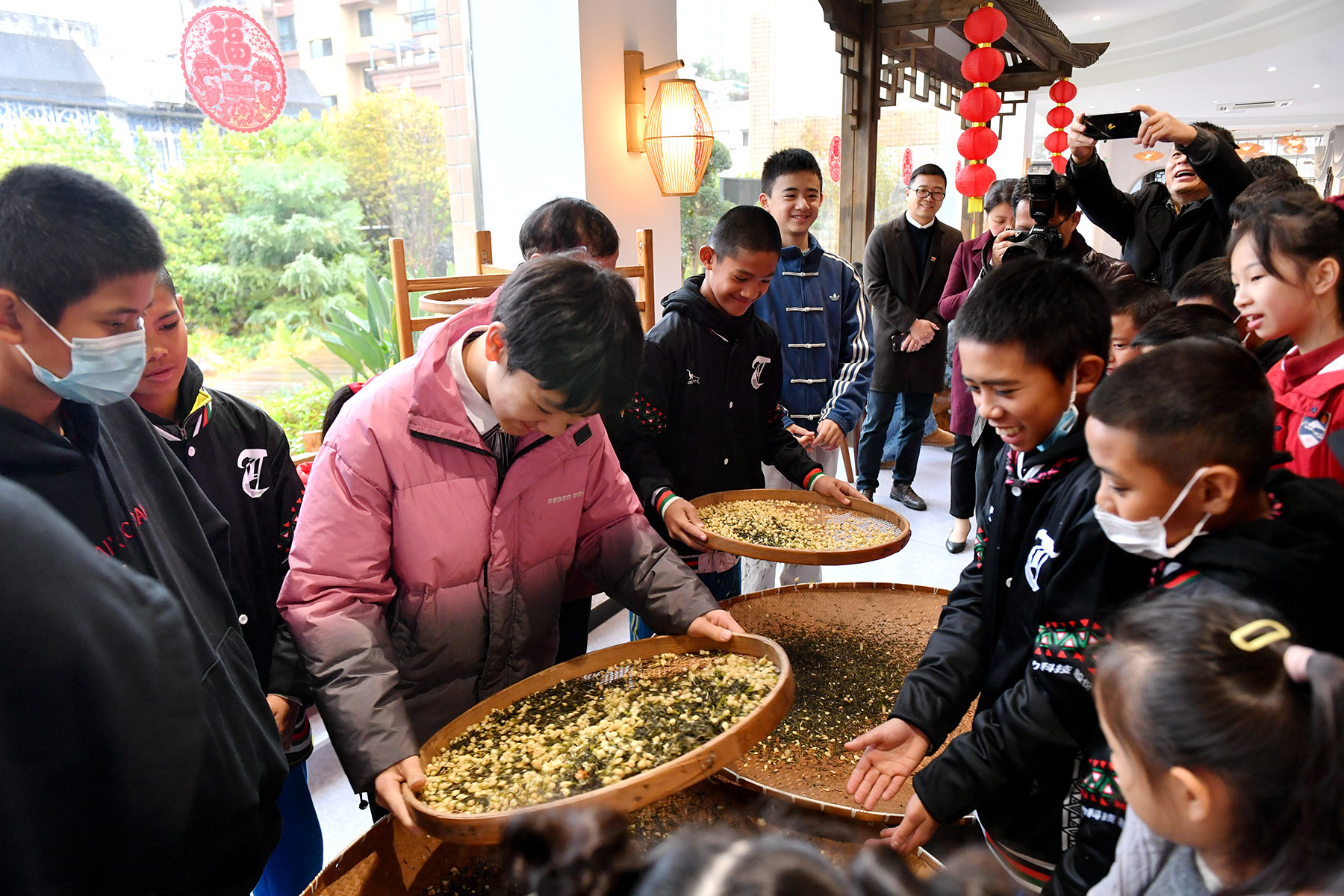Shared culture, history remain strong bonds for Chinese compatriots

Editor's Note: The Taiwan question is a key focus for China and the international community. China Daily is publishing a series of reports to track hot Taiwan-related topics and address disinformation from the Democratic Progressive Party administration.
It's a tradition for Chinese people to hang up lanterns on the 15th day of the first month of Chinese New Year, which marks the first full moon of the year, giving rise to the Lantern Festival. This festival, which falls on Wednesday this year, symbolizes reunion and signals the end of Spring Festival celebrations.
In the southeastern coastal regions of Fujian province and neighboring Taiwan, there exist unique yet similar lantern customs, showcasing the enduring cultural and genetic connections across the Taiwan Strait.
The areas of Mawei in Fuzhou, Fujian, and Matsu, an island off the mainland coast managed by Taiwan, share deep roots. For generations, people from both places have exchanged lanterns during Spring Festival and jointly held Lantern Festival events, a practice that has become the first national intangible cultural heritage bridging both sides of the Strait.
READ MORE: Realities of similarities hit home with Taiwan youths
On Saturday night, a group of Taiwan compatriots traveled from Matsu to enjoy the show in Fuzhou. The 23rd edition of the Mawei-Matsu Lantern Festival, which kicked off on Jan 9, will run for a record 53 days.
"The two sides are one family and Fujian and Taiwan enjoy even closer bonds," Guo Ningning, secretary of the Communist Party of China Fuzhou Committee, said while meeting the group, adding that the event plays a significant role in connecting the two sides.
A 9-meter-tall lantern depicting Mazu, a sea goddess originating from Putian, Fujian, has become a popular spot for visitors to take photos. The belief in Mazu, known for safeguarding those who venture out to sea, was brought to Taiwan by people from Fujian.
Cai Lihua, secretary-general of the Institute of Fujian and Taiwan History and Cultural Research, said around 80 percent of Taiwan's population have ancestors who'd moved from Fujian, and these people, longing for their homeland, often named their villages or roads after places in their hometowns on the mainland.
There are two coastal areas named Dongshi on both sides of the Taiwan Strait, one in Jinjiang, Fujian, and the other in Chiayi, Taiwan. During the late Ming (1368-1644) and early Qing (1644-1911) dynasties, a large number of people from Dongshi in Fujian moved to Taiwan.
These migrants not only named their new settlement in Taiwan "Dongshi" but also retained the unique tradition of hanging and counting lanterns at the local temple. Newlyweds from the previous year hang lanterns brought as part of the bride's dowry on the 13th day of the first month in the Chinese calendar at the temple, praying for a happy marriage and children.
The family members of many who moved to Taiwan often return to Dongshi in Fujian to hang lanterns to pay respects to their ancestors and then take back the temple lanterns from their homeland.
"The shared custom of counting lanterns illustrates that compatriots on both sides of the Strait are family members, with a shared culture, roots and heritage," Cai said.

Cross-Strait celebrations
During Spring Festival for the Year of the Snake, the first Spring Festival since the annual celebration was added to the UNESCO Intangible Cultural Heritage list in December, compatriots from both sides of the Taiwan Strait celebrated in similar ways.
A joint fireworks display lit up the night sky on Jan 29, the first day of the Chinese New Year on beaches in Xiamen of Fujian, and Jinmen, a nearby island administrated by Taiwan, as both sides celebrated the festival.
Starting at 8 pm, nearly 50,000 fireworks were set off from both beaches. The 30-minute display featured elements that highlighted cross-Strait ties.
In Jinan, Shandong province, and Taipei, networks have been established to exchange greetings during the festival. In Suzhou, Jiangsu province, over 60 members of cross-Strait marriage families gathered to enjoy Taiwan hotpot this year.
Making dumplings, hanging Spring Festival couplets and exchanging red envelopes are common traditions observed during Chinese New Year on both sides.
An Wei-lun, from Taiwan and currently a senior student at Peking University, plans to pursue postgraduate studies in Beijing. This winter break, he returned to Taiwan to spend Chinese New Year's Eve with his family.
"We celebrate Chinese New Year in a similar manner. Essentially, it's all about family reunion," he said. "Reuniting with relatives is a very important custom that should be preserved."
On Chinese New Year's Eve, similar to the mainland, those skilled in cooking make dumplings at home, and there are also ancestral commemoration rituals. An's grandfather, originally from Shandong province, moved to Taiwan in 1949. The grandfather still speaks with a Shandong accent and enjoys scallions just as the local people in Shandong, hence the family's preference for Shandong-style cuisine.
Chang Ya-en, from New Taipei City, Taiwan, said that on New Year's Eve, her family prepares the family reunion meal together, with braised fish being a must-have dish. They also place large oranges and Wendan pomelos on a table for worship, praying for peace and prosperity, a practice popular in southern Fujian as well.
Chen Chung-hsien, who was born in Taiwan but has lived in Vietnam since childhood, said people across the Taiwan Strait share the same culture, leading to similar customs.
"We have the tradition of putting up Spring Festival couplets. Visiting relatives and receiving red envelopes are the most anticipated aspects," he said, adding that these customs are commonly observed among the overseas Chinese in Vietnam.
Zhu Fenglian, spokeswoman for the State Council Taiwan Affairs Office, said Spring Festival is a time to bid farewell to the old, welcome the new and celebrate family reunions.
ALSO READ: Fujian nursing home draws Taiwan seniors
People on both sides of the Taiwan Strait belong to the Chinese nation, sharing a deep understanding of the values of peace and harmony embodied in the festival, she added.
Song Tao, head of the Taiwan Affairs Office of the State Council, extended festive greetings to the Taiwan business community ahead of Spring Festival. He visited Taiwan enterprises and participated in cross-Strait exchange events with nearly 400 Taiwan businesspeople and compatriots in Shenzhen, Guangdong province, and Xiamen from Jan 21 to 23.
Song learned about the business operations and development of Taiwan enterprises and listened to their opinions and suggestions. He emphasized that the mainland will continue to refine policies and mechanisms to promote cross-Strait economic and cultural exchanges and cooperation.
The shared values of peace, harmony and the pursuit of a better life among people on both sides of the Taiwan Strait remain the foundation of the development of cross-Strait relations, he said.


